Related Research Articles

The Boletaceae are a family of mushroom-forming fungi, primarily characterised by small pores on the spore-bearing hymenial surface, instead of gills as are found in most agarics. Nearly as widely distributed as the agarics, the family is renowned for hosting some prime edible species highly sought after by mushroom hunters worldwide, such as the cep or king bolete . A number of rare or threatened species are also present in the family, that have become the focus of increasing conservation concerns. As a whole, the typical members of the family are commonly known as boletes.
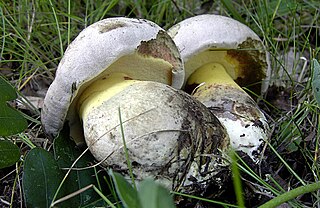
Caloboletus radicans, also known as the rooting bolete or whitish bolete, is a large ectomycorrhizal fungus found in Europe under broad-leaved trees, fruiting during the summer and autumn months. It has a pale buff or greyish-white cap, yellow pores and a stout stipe, and stains intensely blue when handled or cut. Bitter and inedible, it can cause severe vomiting and diarrhoea if eaten. Until 2014 it was placed in genus Boletus, but has since been transferred to the new genus Caloboletus based on molecular phylogenetic data.

Hortiboletus rubellus, commonly known as the ruby bolete, is a small, dainty, brightly coloured member of the family Boletaceae, with a reddish cap and stipe, and yellow pores. Like many boletes, it stains blue when cut or bruised. It is found in deciduous woodland in autumn. There is some question over its edibility, and it is reportedly of poor quality with a taste of soap. Until 2015, the species was known as Boletus rubellus.

Xerocomus subtomentosus, commonly known as suede bolete, brown and yellow bolete , boring brown bolete or yellow-cracked bolete, is a species of bolete fungus in the family Boletaceae. The fungus was initially described by Carl Linnaeus in 1753 and known for many years as Boletus subtomentosus. It is edible, though not as highly regarded as other bolete mushrooms.

Exsudoporus frostii, commonly known as Frost's bolete or the apple bolete, is a bolete fungus first described scientifically in 1874. A member of the family Boletaceae, the mushrooms produced by the fungus have tubes and pores instead of gills on the underside of their caps. Exsudoporus frostii is distributed in the eastern United States from Maine to Georgia, and in the southwest from Arizona extending south to Mexico and Costa Rica. A mycorrhizal species, its fruit bodies are typically found growing near hardwood trees, especially oak.
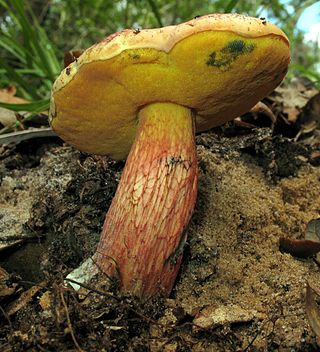
Exsudoporus floridanus is a species of edible bolete mushroom in the family Boletaceae. In 1945, American mycologist Rolf Singer described a species he found in Florida during his 1942–3 tenure of a Guggenheim Memorial Fellowship. He originally described it as a subspecies of the eastern North American species Boletus frostii, but later considered it worthy of distinct species status in a 1947 publication. Based on morphological and phylogenetic data, Vizzini and colleagues transferred this species to a newly described genus Exsudoporus in 2014. Due to lack of sufficient sequences, Wu et al. (2016) were reluctant to accept Exsudoporus and considered it a synonym of Butyriboletus, so they proposed a new combination Butyriboletus floridanus. However, following phylogenetic and morphological analyses clearly resolved Exsudoporus as a monophyletic, homogenous and independent genus that is sister to Butyriboletus.

Xerocomellus is a genus of fungi in the family Boletaceae. The genus, as it was described in 2008, contained 12 species. However X. rubellus and X. engelii were transferred to the new genus Hortiboletus and X. armeniacus was transferred to the new genus Rheubarbariboletus in 2015. Molecular analysis supports the distinction of Xerocomellus species from Boletus and Xerocomus, within which these species were formerly contained. Xerocomellus in fact is only distantly related to Xerocomus and is most closely related to Tylopilus, Boletus sensu stricto, Porphyrellus, Strobilomyces, and Xanthoconium.

Imperator luteocupreus is a species of bolete fungus in the family Boletaceae. It is native to southern Europe, where it is found under chestnut (Castanea) and oak (Quercus). Although it was originally described in genus Boletus, it was placed in the new genus Imperator in 2015, based on phylogenetic inferences.
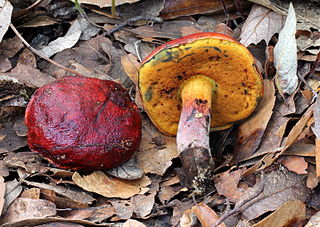
Rubroboletus dupainii, commonly known as Dupain's bolete, is a bolete fungus of the genus Rubroboletus. It is native to Europe, where it is threatened, and red listed in six countries. It also occurs in North America, although it is rare there. It was first recorded from North Carolina, and then from Iowa in 2009. It was reported from Belize in 2007, growing under Quercus peduncularis and other oaks.

Xanthoconium stramineum is a species of bolete fungus and the type species of the genus Xanthoconium. First described as a species of Gyroporus by William Alphonso Murrill in 1940, it was placed in its current genus by Rolf Singer in 1944.

Chalciporus pseudorubinellus is a bolete fungus of the family Boletaceae. It is found in North America and Central America.
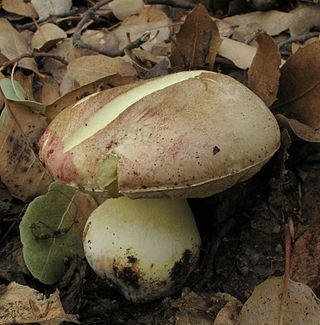
Butyriboletus querciregius is a pored mushroom in the genus Butyriboletus. Found in California, where it grows in a mycorrhizal association with coast live oak, it was described as new to science in 2014.
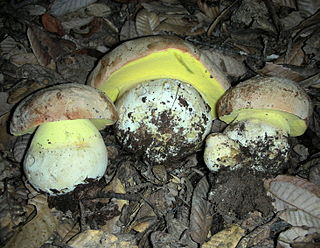
Butyriboletus persolidus is a pored mushroom in the family Boletaceae. Found in California, where it grows in a mycorrhizal association with coast live oak, it was described as new to science in 2014.

Xanthoconium affine is a species of edible bolete fungus of the genus Xanthoconium. First described as a species of Boletus by Charles Horton Peck in 1873, it was placed in its current genus by Rolf Singer in 1944.

Sutorius eximius, commonly known as the lilac-brown bolete, is a species of fungus in the family Boletaceae. This bolete produces fruit bodies that are dark purple to chocolate brown in color with a smooth cap, a finely scaly stipe, and a reddish-brown spore print. The tiny pores on the cap underside are chocolate to violet brown. It is widely distributed, having been recorded on North America, South America, and Asia, where it grows in a mycorrhizal relationship with both coniferous and deciduous trees.
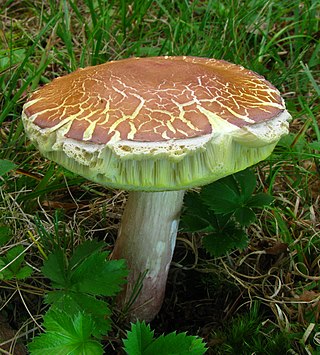
Boletus separans is a species of bolete fungus in the family Boletaceae. It was described as new to science in 1873 by American mycologist Charles Horton Peck. In 1998, Roy Halling and Ernst Both transferred the bolete to the genus Xanthoconium. Molecular phylogenetic analysis published in 2013 shows that it is more closely related to Boletussensu stricto than to Xanthoconium.
Xanthoconium montaltoense is a species of bolete fungus in the genus Xanthoconium. Described as new to science in 1987, it is found in Pennsylvania, where it grows on soil under Betula lenta and Tsuga canadensis. The specific epithet montaltoense refers to Mont Alto campus of Pennsylvania State University, close to the type locality.
Xanthoconium montanum is a species of bolete fungus in the genus Xanthoconium. Described as new to science in 1987, it is found in North Carolina, where it grows on sandy soil under Pinus strobus, Tsuga canadensis, and Rhododendron maximum. The specific epithet montanum refers to the location of the type collection, in the mountains of southwestern North Carolina.
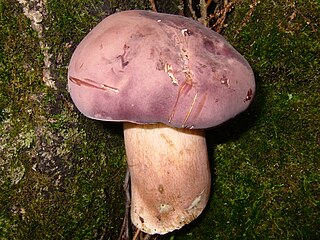
Xanthoconium purpureum is a species of bolete fungus in the genus Xanthoconium. It was described as new to science in 1962 by Wally Snell and Esther Dick in 1962. It is found in eastern North America, where it fruits under oak, sometimes in oak-pine forests.
References
- ↑ Wolfe Jr CB. (1987). "Studies in the genus Xanthoconium (Boletaceae). I. New species and a new combination". Canadian Journal of Botany. 65 (10): 2142–2146. doi:10.1139/b87-295.